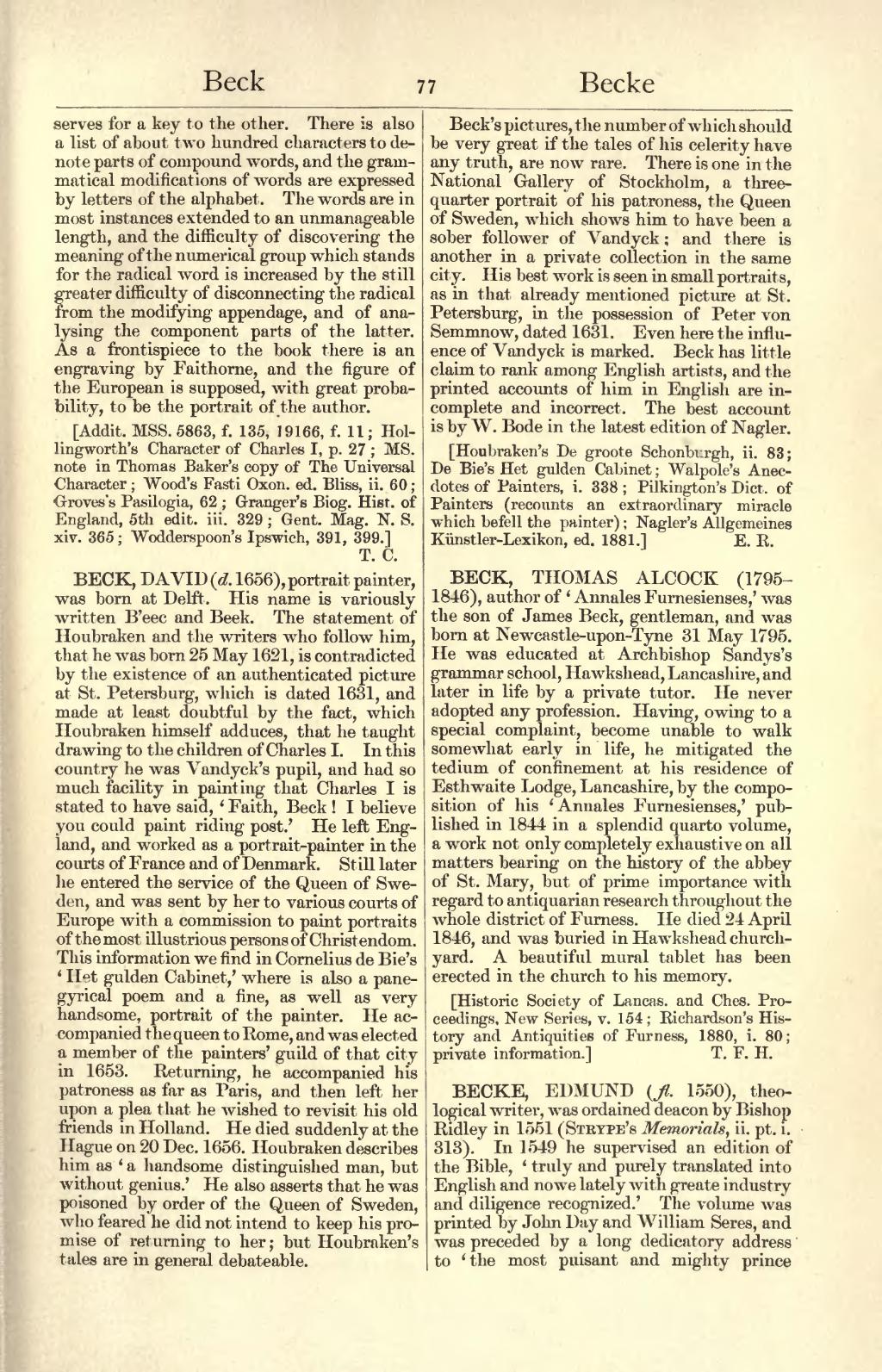serves for a key to the other. There is also a list of about two hundred characters to denote parts of compound words, and the grammatical modifications of words are expressed by letters of the alphabet. The words are in most instances extended to an unmanageable length and the difficulty of discovering the meaning of the numerical group which stands for the radical word is increased by the still greater difficulty of disconnecting the radical from the modifying appendage, and of analysing the component parts of the latter. As a frontispiece to the book there is an engraving by Faithorne, and the figure of the European is supposed, with great probability, to be the portrait of the author.
[Addit. MSS. 5863, f. 135, 19166, f. 11; Hollingworth's Character of Charles I, p. 27; MS. note in Thomas Baker's copy of The Universal Character; Wood's Fasti Oxon. ed. Bliss, ii. 60; Groves's Pasilogia, 62; Granger's Biog. Hist. of England, 5th edit. iii. 329; Gent. Mag. N. S. xiv. 365; Wodderspoon's Ipswich, 391, 399.]
BECK, DAVID (d. 1656), portrait painter, was born at Delft. His name is variously written B'eec and Beek. The statement of Houbraken and the writers who follow him, that he was born 25 May 1621, is contradicted by the existence of an authenticated picture at St. Petersburg, which is dated 1631, and made at least doubtful by the fact, which Houbraken himself adduces, that he taught drawing to the children of Charles I. In this country he was Vandyck's pupil, and had so much facility in painting that Charles I is stated to have said, 'Faith, Beck! I believe you could paint riding post.' He left England, and worked as a portrait-painter in the courts of France and of Denmark. Still later he entered the service of the Queen of Sweden, and was sent by her to various courts of Europe with a commission to paint portraits of the most illustrious persons of Christendom. This information we find in Cornelius de Bie's 'Het gulden Cabinet,' where is also a panegyrical poem and a fine, as well as very handsome, portrait of the painter. He accompanied the queen to Rome, and was elected a member of the painters' guild of that city in 1653. Returning, he accompanied his patroness as far as Paris, and then left her upon a plea that he wished to revisit his old friends in Holland. He died suddenly at the Hague on 20 Dec. 1656. Houbraken describes him as 'a handsome distinguished man, but without genius.' He also asserts that he was poisoned by order of the Queen of Sweden, who feared he did not intend to keep his promise of returning to her; but Houbraken's tales are in general debateable.
Beck's pictures, the number of which should be very great if the tales of his celerity have any truth, are now rare. There is one in the National Gallery of Stockholm, a three-quarter portrait of his patroness, the Queen of Sweden, which shows him to have been a sober follower of Vandyck; and there is another in a private collection in the same city. His best work is seen in small portraits, as in that already mentioned picture at St. Petersburg, in the possession of Peter von Semmnow, dated 1631 . Even here the influence of Vandyck is marked. Beck has little claim to rank among English artists, and the printed accounts of him in English are incomplete and incorrect. The best account is by W. Bode in the latest edition of Nagler.
[Houbraken's De groote Schonburgh, ii. 83; De Bie's Het gulden Cabinet; Walpole's Anecdotes of Painters, i. 338; Pilkington's Dict. of Painters (recounts an extraordinary miracle which befell the painter); Nagler's Allgemeines Künstler-Lexikon, ed. 1881.]
BECK, THOMAS ALCOCK (1795–1846), author of 'Annales Furnesienses,' was the son of James Beck, gentleman, and was
born at Newcastle-upon-Tyne 31 May 1795.
He was educated at Archbishop Sandys's
grammar school, Hawkshend, Lancashire, and
later in life by a private tutor. He never
adopted any profession. Having, owing to a
special complaint, become unable to walk
somewhat early in life, he mitigated the
tedium of confinement at his residence of
Esthwaite Lodge, Lancashire, by the composition of his 'Annales Furnesienses,' published in 1844 in a splendid quarto volume,
a work not only completely exhaustive on all
matters bearing on the history of the abbey
of St. Mary, but of prime importance with
regard to antiquarian research throughout the
whole district of Furness. He died 24 April
1846, and was buried in Hawkshead churchyard. A beautiful mural tablet has been
erected in the church to his memory.
[Historic Society of Lancas. and Ches. Proceedings, New Series, v. 154; Richardson's History and Antiquities of Furness, 1880, i. 80; private information.]
BECKE, EDMUND (fl. 1550), theological writer, was ordained deacon by Bishop
Ridley in 1551 (Strype's Memorials, ii. pt. i.
313). In 1549 he supervised an edition of
the Bible, 'truly and purely translated into
English and nowe lately with greate industry
and diligence recognized.' The volume was
printed by John Day and William Seres, and
was preceded by a long dedicatory address
to 'the most puisant and mighty prince
